Physical Address
304 North Cardinal St.
Dorchester Center, MA 02124
The mediastinum is the body compartment limited by the thoracic inlet superiorly, the sternum anteriorly, the spine dorsally, the diaphragm inferiorly, and both pleural cavities laterally. Although there are no anatomic boundaries between compartments, for teaching purposes, the mediastinum is divided into three parts: anterior, middle, and posterior. The boundaries of the anterior mediastinum are the sternum in front, the trachea, great vessels, and pericardium posteriorly and the pleurae and lungs on each side. This compartment contains the thymus, lymphoid structures, and nerves and vessels embedded in a connective tissue and fatty environment. The middle mediastinum contains the trachea, mainstem bronchi, the heart, and the great vessels as well as the hilar lymph nodes. The posterior component, which is located between the posterior pericardium and the vertebral column, accommodates the aorta, the thoracic esophagus, and the sympathetic nerve chains. Other anatomic sources subdivide the mediastinal space into superior and inferior, the latter including the anterior, middle, and posterior compartments.
The foregut runs longitudinally in the middle of the embryonic mediastinum and differentiates to form the tracheobronchial tree and the esophagus. The tracheobronchial tree and the lungs originate from a ventral bud emerging from the foregut that subsequently grows and branches, while interacting with the surrounding mesenchyme to produce the lungs. Neural crest cells migrate along the foregut axis to innervate the gastrointestinal tract and to form the sympathetic chains. The anterior midline is one of the pathways by which embryonal germ cells migrate towards their final settlement in the gonads. The thymus is derived from paired primordia located in the third pharyngeal pouches that subsequently migrate into the anterior mediastinum, where they fuse to form a single organ. All these gestational events explain why tracheobronchial and esophageal malformations, neural crest and germ cell tumors, and thymic tumors and cysts are often located in the mediastinum. Finally, the lymphaticovenous confluence and the vascular structures in the upper mediastinum are at the origin of some vascular tumors and malformations in this area.
Mediastinal tumors in children are rare. They involve a variety of congenital or neoplastic masses ( Table 25.1 ). Their location in either one of the aforementioned compartments gives some clues about their nature. The more frequent location of the different mediastinal tumors is summarized in Table 25.2 . Although there are exceptions, the usual masses located in the anterior mediastinum in children are lymphomas, germ cell tumors, and thymomas. The more common ones of the middle compartment are lymph nodes, lymphomas, and cysts. Finally, those located in the posterior mediastinum are usually neurogenic tumors or foregut cysts. Approximately 40% of mediastinal masses are benign, and 60% are malignant. Nearly 40% of all of them occur in children <2 years of age. For example, in a recent review from the University of Colorado, among 69 anterior or middle mediastinal masses, 43% proved to be Hodgkin lymphoma, 25% were non-Hodgkin lymphoma, 17% were leukemia, and 9% were histoplasmosis. In contrast, the prevalence of malignancy for all mediastinal masses in adults approaches 50%.
| Neurogenic Tumors | Mesenchymal Tumors |
|---|---|
| Neurofibroma | Fibroma/fibrosarcoma |
| Neurilemoma | Lipoma/lipoblastoma/liposarcoma |
| Neurosarcoma | Leiomyoma/leiomyosarcoma |
| Ganglioneuroma | Rhabdomyosarcoma |
| Neuroblastoma | Xanthogranuloma |
| Chemodectoma | Myxoma |
| Paraganglioma | Mesothelioma |
| Thymoma | Hemangioma |
| Benign | Vascular tumors |
| Malign | Lymphangioma and lymphatic lesions |
| Lymphoma | Endocrine Tumors |
| Hodgkin disease | Intrathoracic thyroid |
| Lymphoblastic | Parathyroid adenoma/carcinoma |
| Large-cell diffuse growth pattern | Carcinoid |
| Germ Cell Tumors | Cysts |
| Benign teratoma | Bronchogenic |
| Malign teratoma | Pericardial |
| Seminoma | Enteric |
| Nonseminomas | Thymic |
| Primary Carcinomas | Giant Lymph Node Hyperplasia |
| Compartment | Benign | Malignant |
|---|---|---|
| Anterior | Teratoma Thymic hyperplasia Thymic cysts (rare) |
Non-Hodgkin lymphoma Hodgkin lymphoma Thymic tumors (rare) Malignant germ-cell tumors Endocrine (rare) |
| Middle | Lymphangioma Foregut cysts and duplications |
Non-Hodgkin lymphoma Hodgkin lymphoma Carcinoma (rare) |
| Posterior | Ganglioneuroma Foregut cysts (rare) |
Neuroblastoma |
Mediastinal tumors and cysts are occasionally diagnosed before birth, and they may even benefit from prenatal instrumentation or from planning an ex utero intrapartum treatment (EXIT) procedure. Most mediastinal masses seen during infancy and childhood do not produce symptoms and are discovered on imaging performed for concurrent conditions. Respiratory embarrassment, orthopnea, stridor, wheezing, or even severe distress and/or superior vena cava syndrome are seen in some instances. Sternal bulging may appear in young infants with large anterior tumors. Recurrent laryngeal or phrenic nerve palsies or Horner syndrome may reveal the presence of the tumor when it involves the nerve trunks/branches. Sudden paraplegia or paraparesis is occasionally observed in dumbbell tumors involving the spinal cord. Secretion of substances such as catecholamines, α-fetoprotein (AFP), or gonadotrophins may act as biomarkers and uncover the tumor.
Current imaging allows accurate preoperative diagnosis in most cases. Collaboration between experienced pediatric radiologists with equally experienced pediatric surgical oncologists greatly helps in arriving at an accurate diagnosis. Plain radiographs of the thorax may show widening of the mediastinal shadow or masses in either hemithorax. Traditionally, the Felson method of mediastinal division is based on a lateral chest radiograph that is usually taken in every patient with the suspicion of a mediastinal mass. These radiographs help localize the lesion in one of the three compartments. Some features can help diagnose the nature of the mass, such as calcifications that suggest a germ cell tumor or spinal cord invasion that is consistent with a mass of neural origin. Ultrasonography (US) may be useful as well, but its use is limited due to the interposition of lung air. It has a role in prenatal diagnosis, in differentiating cystic from solid masses, and in some biopsy procedures.
Cross-sectional imaging (computed tomography [CT] or magnetic resonance imaging [MRI]) is the standard approach to characterize mediastinal masses and to help surgical planning. CT scans help to locate the tumor and give information about its cystic or solid nature, and allow identification of calcifications, necrotic areas, and other details such as widening of the spinal foramina in cases with intraspinal extension. Calcifications are suggestive of neuroblastoma or teratoma, but other tumors, such as lymphangiomas or some histiocytoses, can have calcified areas. CT scan is also important for assessing the patency of the airway and the risks of anesthesia. MRI is used to better define the nature of the masses of vascular origin, but it may be very useful in other tumors as well, particularly for exploring the intraspinal space, and to differentiate between cystic and solid lesions. Finally, fluorodeoxyglucose-positron emission tomography ( 18 FDG-PET), combined with either CT or MRI, is very useful in patients with lymphoma. Pulmonary function tests are seldom necessary in the preoperative assessment.
In some tumors, particularly in those for which surgery is not the primary treatment such as lymphomas, histology and cell markers and molecular biology features must be ascertained before undertaking therapy. Cells can be obtained by fine-needle aspiration (FNA) guided by US or CT scan, by pleural or pericardial fluid aspiration, or even by new endoscopic US-guided devices. Unfortunately, they do not usually provide enough material for characterizing lymphomas. However, often a larger sample can be obtained by biopsy of distant lymph nodes in the cervical or suprasternal notch areas. Thoracoscopy or anterior mini-thoracotomy through the bed of the second or third rib (the Chamberlain approach) may allow access for biopsy. Mediastinoscopy is rarely performed in children.
Anesthesia must take into account the possible respiratory collapse that can occur after induction and before relaxation. Ventilation can be critically difficult, particularly in children with anterior masses such as lymphomas. This risk is increased because of a restrictive ventilatory compromise that is due to a marked reduction in the maximum expiratory flow rate, a decreased venous return, and increased pulmonary pressure due to the anterior mediastinal mass. Several reports have attempted to correlate clinical symptoms and anesthetic complications, but the only strongly associated one was orthopnea. Along with a reduction of 50% of predicted tracheal cross-sectional area on the preoperative CT scan, mainstem bronchus and great vessel compression, orthopnea, and upper body edema should also be considered as risk factors for anesthetic complications.
Every effort should be directed to perform an extrathoracic approach under local anesthesia to diagnose the etiology of an anterior mediastinal mass. Often, cervical nodes are present and accessible. However, if general anesthesia cannot be avoided, surgical and anesthesiology teams should design an individualized plan based on the preoperative clinical and radiologic findings ( Fig. 25.1 ). Steroids and/or radiation therapy have been used in a small subset of patients prior to tissue biopsy to reduce the risk of cardiorespiratory complications. Fiberoptic or rigid bronchoscopy should be available at the operating room in the event of difficult airway intubation. Extracorporeal membrane oxygenation (ECMO) should also be considered as the final option in some critical children with mediastinal masses and should be planned and prepared before anesthetic induction.
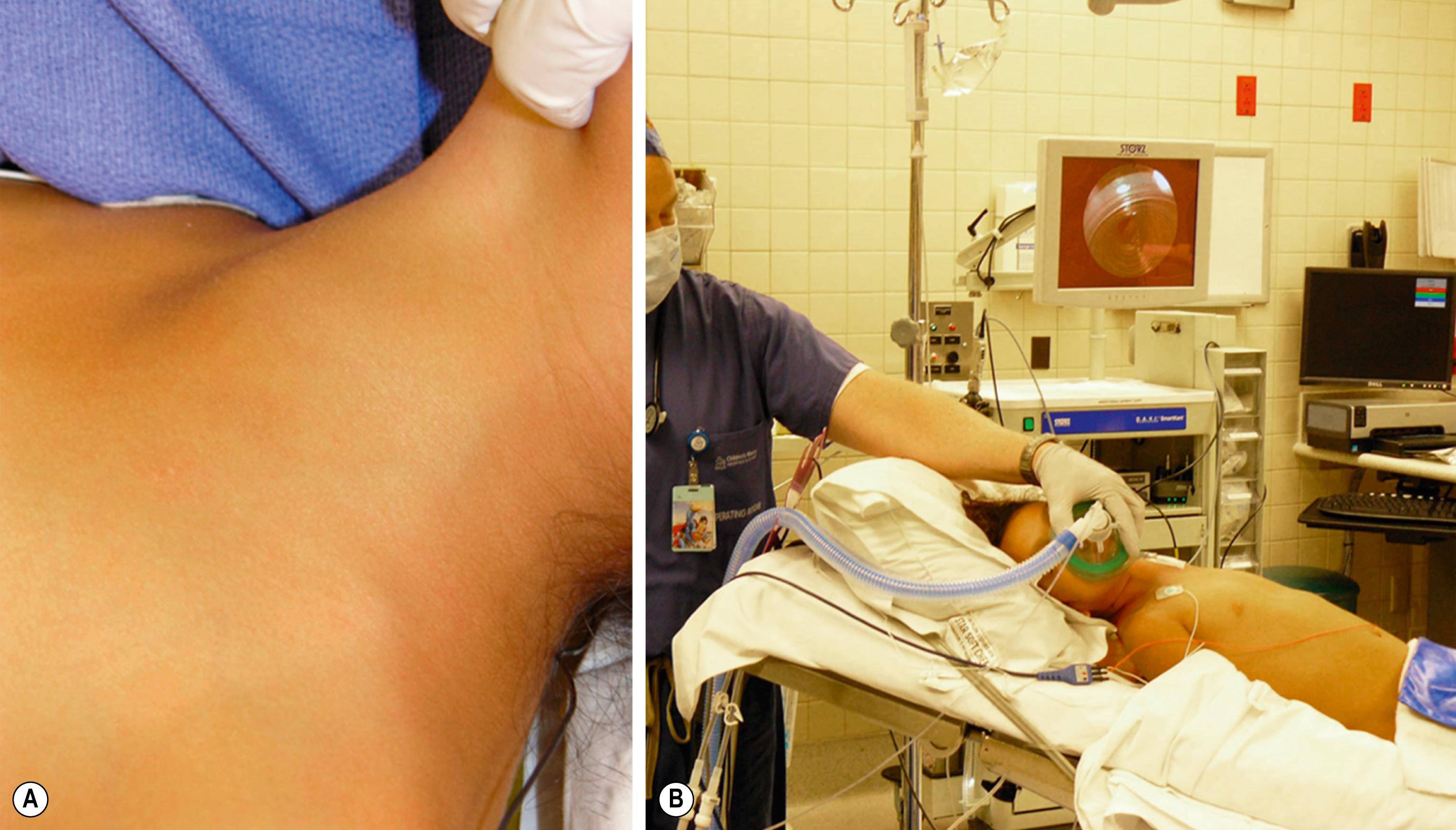
As will be discussed in the text that follows, with the exception of lymphomas that are better treated with chemotherapy and/or radiotherapy and require surgery only as an adjuvant, all other mediastinal masses in children should be removed. The operation can be accomplished by median sternotomy, which is an excellent approach in terms of exposure and postoperative pain, by “trap-door” or “clamshell” approaches, or by thoracotomy on either side, depending on the anatomic extension of the mass. Thoracoscopy or video-assisted thoracoscopic surgery (VATS) are alternatives in some cases, although these approaches must comply with the principles of oncologic surgery, avoiding spillage of tumor cells or fluids, particularly in germ cell tumors. These less invasive techniques offer less postoperative pain, less atelectasis, and shorter hospital stay in selected patients, but their use precludes palpation of the lesions and increases the risk of tumor rupture and tumor port site recurrences.
In the last three years, the WHO (World Health Organization) Classification of Hematopoietic and Lymphoid Tumors has been expanded by molecular genetics, biology, and the clinical behavior of lymphoma. More than 50 types of lymphoma have now been identified based on histopathologic, immunohistochemical, cytogenetic, and molecular analyses, although in daily clinical practice, only a few subtypes account for the majority of cases.
Non-Hodgkin lymphoma (NHL) is one of the more frequent tumors of the mediastinum. NHL is a systemic disease in which there is massive proliferation of lymphoblasts in the lymph nodes. Lymphoblasts can be ontogenically divided into B-cells, related to humoral immunity and produced in the bone marrow, and T-cells, involved in cellular immunity that are processed in the thymus. In children, B-cells cause undifferentiated Burkitt or non-Burkitt lymphomas, which constitute about 50% of all lymphomas, and are more often located in the abdominal organs, whereas T-cells cause lymphoblastic lymphomas (about 40% of all), generally located in the thymus and/or lymph nodes of the anterior mediastinum. Finally, the remaining 10% correspond to large-cell lymphomas, quite similar to undifferentiated tumors, but may be of T- or B-cell origin and can be found on either side of the diaphragm.
There are many cell surface markers and chromosomal abnormalities that help to categorize lymphomas and, at the same time, provide information about prognosis. Undifferentiated lymphomas express surface IgM and CD19 and CD20 antigens, whereas lymphoblastic lymphomas contain the enzyme terminal deoxynucleotide transferase (TdT) and express T-cell markers such as CD5 and CD7. Burkitt lymphoma expresses a spectrum of surface B-cell markers including CD19, CD20, or CD22. The IG-MYC translocation t(8;14) is the mutation that describes molecular genetic alterations in Burkitt lymphoma. Other chromosomal abnormalities involve oncogenes such as TAL1 , LMO2 , LYL1 , HOXA9 , TLX1 , and TLX3 . Among children with T-cell lymphoma, Notch 1 mutations have been associated with a better prognosis, whereas LOH6q (loss of heterozygosity at 6q) is associated with a worse prognosis.
At the time of diagnosis, most of these tumors have spread beyond the original site and involve the regional nodes and other areas such as the pleural or pericardial spaces, or the bone marrow (where they are practically undistinguishable from acute lymphoblastic leukemia [ALL]). The liver and other abdominal organs and the central nervous system can occasionally be involved as well.
Rapid growth of mediastinal lymphomas can compress the airway causing respiratory distress, wheezing, and/or orthopnea. The superior vena cava can be compressed as well, generating cervicofacial edema and jugular distention. Systemic symptoms are possible, and hematologic abnormalities may appear when the bone marrow is invaded. Lymph nodes may be enlarged and palpable elsewhere, particularly in the neck, axillae, or supraclavicular/suprasternal regions.
Non-Hodgkin and Hodgkin lymphoma have been classically staged with the Ann Arbor system that was introduced in 1971 and modified in 1989 to include the Cotswolds modifications. More recently, the introduction of 18 F-FDG-PET/CT has allowed simplification and standardization of staging and treatment response. This new staging system, known as the Lugano classification, serves as a unified guideline for diagnosis and management. The functional and anatomic images obtained by PET/CT classify patients into “limited” (previously Ann Arbor stage I or II) or “advanced” (previously stage III or IV) disease. The response assessment is divided into four categories: complete, partial, stable, and progressive disease, depending on the metabolic activity indicated by FDG uptake.
Imaging depicts an enlargement of the mediastinum with or without involvement of the airway. This should be differentiated from the thymic enlargement seen in some normal young children. Sometimes fluid can be present in the pleural or pericardial spaces ( Fig. 25.2 ), and its recovery allows for cytologic analysis. If neither peripheral lymph nodes nor fluids are available for biopsy or puncture, FNA under US or CT is utilized for cytologic analysis. The role of 18 F-FDG PET-CT is essential for detecting disease outside the mediastinum in order to reduce the risks of an operative biopsy ( Fig. 25.3 ). However, when these lesions are not present outside the chest, biopsy by thoracoscopy or the anterior Chamberlain approach may be necessary. In both cases, the anesthetic risks and precautions should be emphasized. (See Chapter 3 for more information on the anesthetic management of anterior mediastinal masses.)
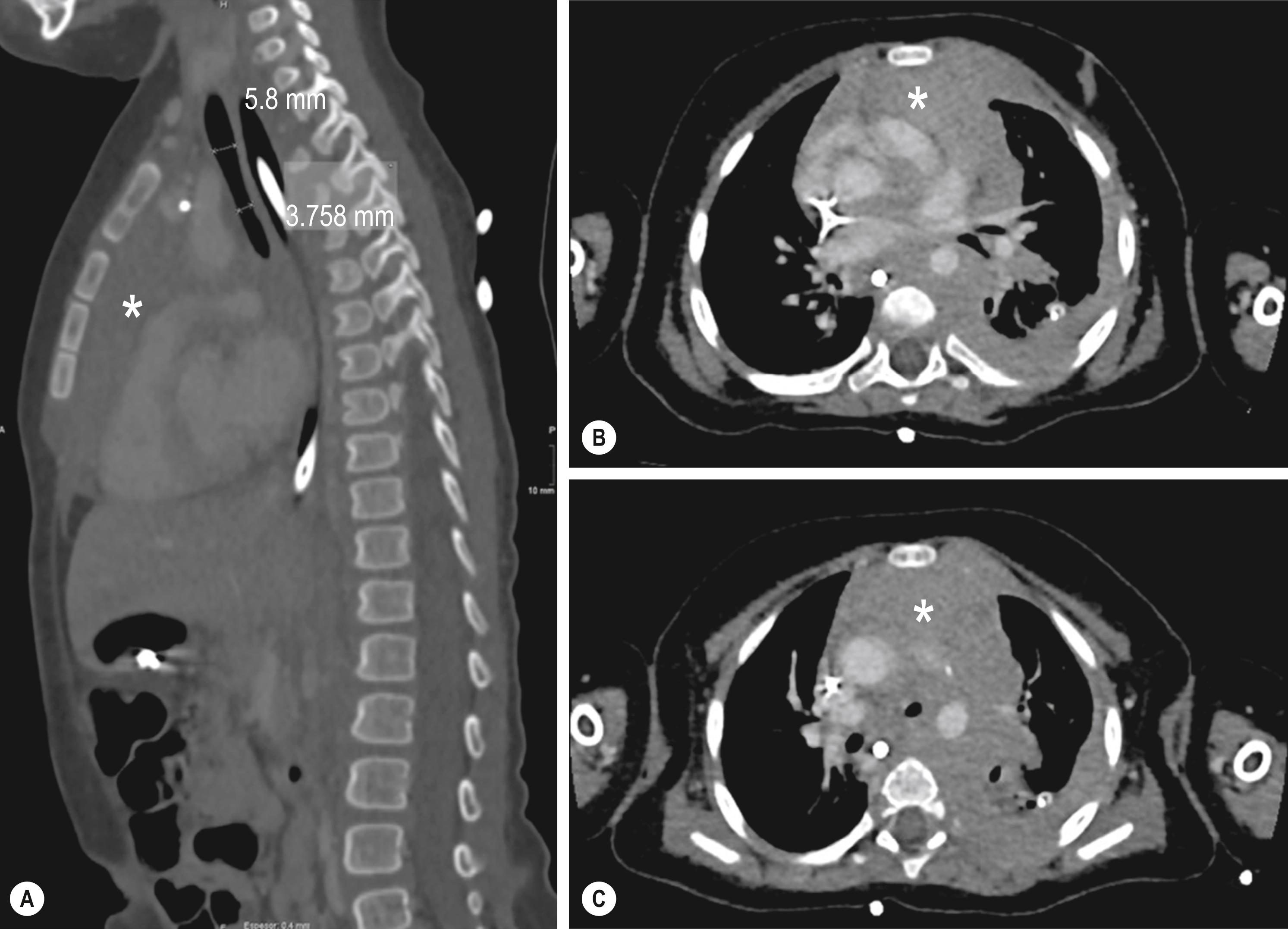
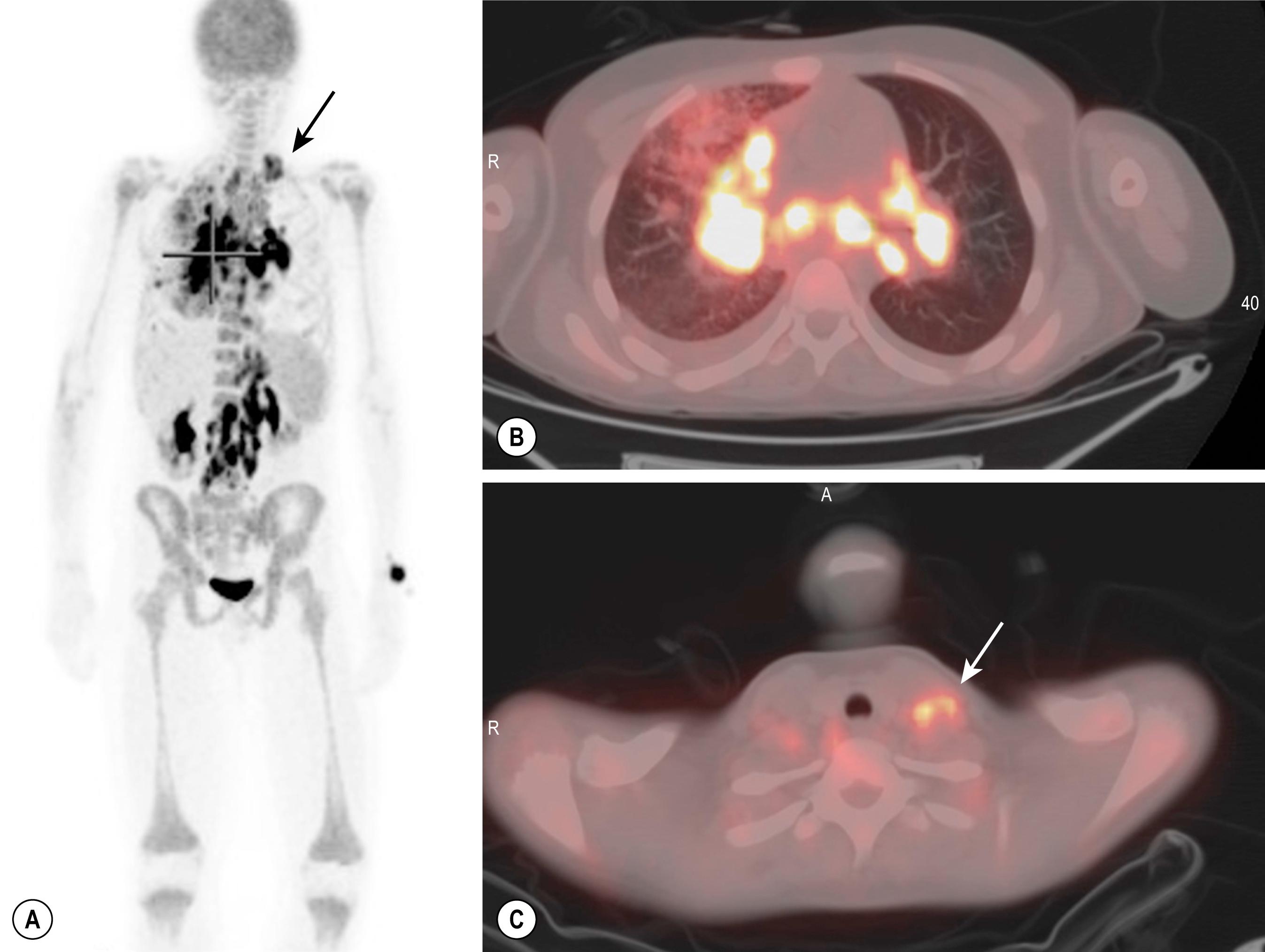
Surgery is not the primary approach in the treatment of mediastinal NHL that responds well to chemotherapy and corticosteroids. The contribution of the surgeon is limited to the recovery of biopsy material adequate for cytologic assessment. Chemotherapy based on ALL protocols leads to long-term survival in >80% of these children.
Hodgkin lymphoma (HL) is less frequent in the mediastinum than NHL, and occurs more often in preadolescent and adolescent individuals. The main identifying component is the Reed–Sternberg cell, which is probably the malignant counterpart of the dendritic interdigitating cell that has a role in antigen presentation. These cells are embedded in lymph nodes in which the proportions of fibrous stroma, lymphocytes, and plasma cells are variable, allowing classification into the following types: lymphocyte predominant, lymphocyte depleted, mixed cellularity, and nodular sclerosis. Most children with HL have the nodular sclerosis type, but the youngest ones may have lymphocyte predominant or mixed cellularity varieties.
HL originates in one group of lymph nodes, but it extends to contiguous or distant ones following lymphatic pathways. Confirmation of diagnosis and histologic classification require biopsies and detailed histologic assessment that is probably not possible on frozen sections alone. The extent of the disease determines the modality and the intensity of the treatment. Therefore, accurate staging is imperative before determining the treatment protocol. The new Lugano classification based on findings of 18 F-FDG PET-CT allows not only initial staging but also assessment of response to therapy.
HL may be localized primarily in the anterior and middle mediastinum in children, and can cause the same compressive effects as NHL. Mediastinal widening is seen on plain radiographs, and CT scans should be obtained in those cases. Anterior superior mediastinal lymph nodes are usually involved in HL. They are usually of homogeneous soft tissue attenuation, typically multiple and conglomerated, often bilateral, and with central necrosis in larger ones. The thymus usually appears as a homogeneously enlarged gland. “Bulky” disease, formerly denoted with an “X” added to the stage, is defined when the mediastinal mass is >10 cm or reaches one-third of the transthoracic diameter.
PET-CT is also a helpful modality for staging and follow-up, but also assists in identifying extrathoracic lesions that are the best option for diagnostic biopsies ( Fig. 25.4 ). Its widespread use has made the classical staging laparotomy and even bone marrow biopsy obsolete. Whenever a pleural or pericardial effusion is present, the fluid can be a source for characterizing the lymphoma. Biopsies are sometimes possible in extrathoracic nodes. If not, the Chamberlain operation or thoracoscopy allow retrieval of tissue for diagnosis ( Fig. 25.5 ).
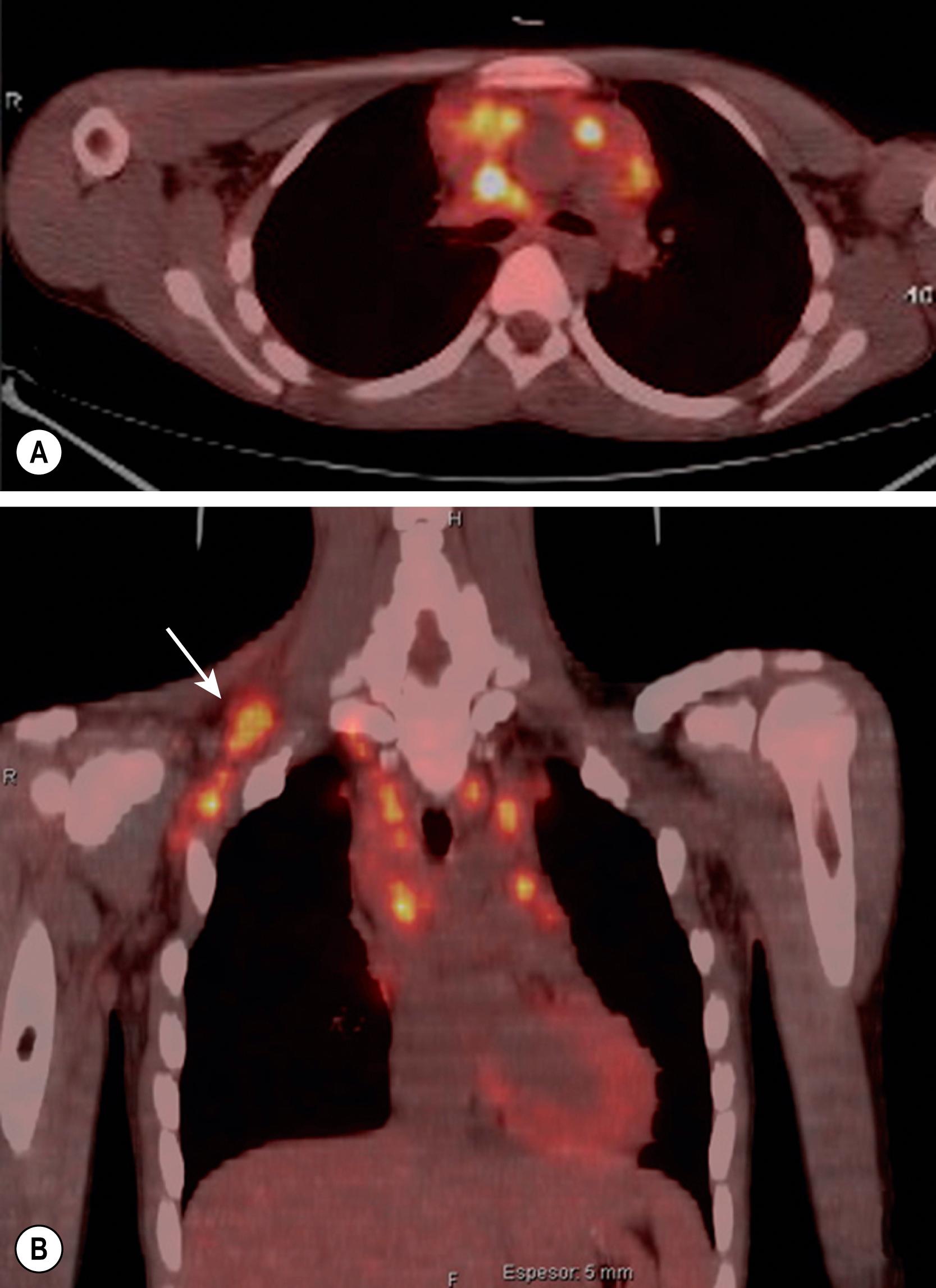
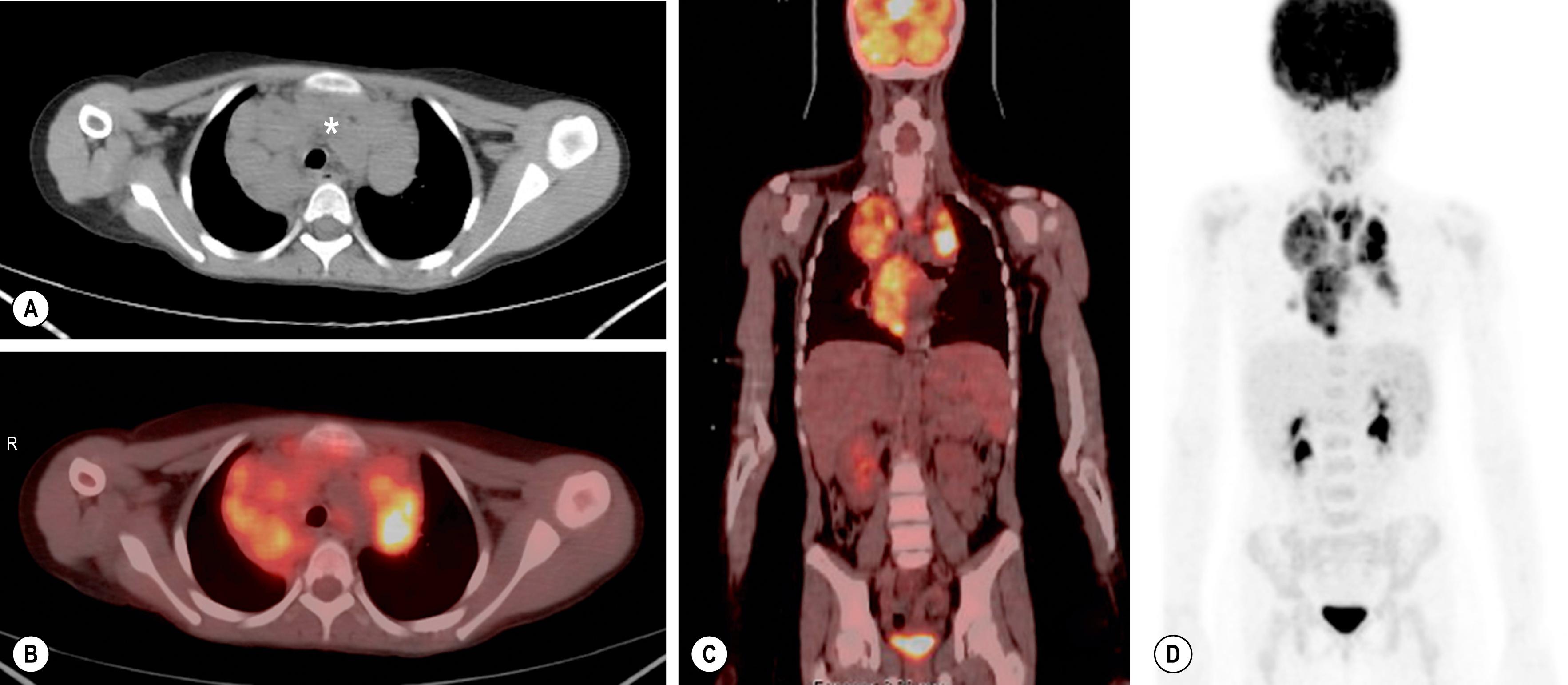
Like in NHL, surgery is not the primary treatment of HL except in very localized cases, in which it may suffice. However, occasionally, it can be helpful in children in whom unusual imaging pictures, such as cystic spaces within the enlarged thymus, are suggestive of other diagnoses. (See Chapter 68 for more information on lymphomas.)
Become a Clinical Tree membership for Full access and enjoy Unlimited articles
If you are a member. Log in here